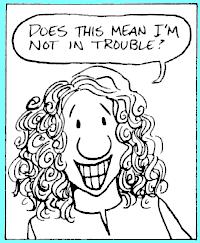Murphy, Jim (2012) The Giant and How He Humbugged America. New York: Scholastic.
On Saturday, October 16, 1869, a farmer digging a well in Cardiff, New York, came upon an astounding discovery. He found what appeared to be a giant petrified human being. It was over 10 feet tall and very detailed, with ribs, toenails and muscles clearly visible. The farmer, a man called Newell, called upon historians, experts, and reporters, and soon a crowd was gathered around the hole. News spread like wildfire and soon Newell was charging admission to the huge crowds that came to see the giant. As the Cardiff giant's fame grew, he seemed to capture the imagination of the entire nation.
Too bad the whole thing was a hoax.
I still remember when I first read about the Cardiff giant, in a SRA article (SRA was an ancient reading program -- sort of the 1970s version of Accelerated Reader) and how fascinated I was by it. Murphy (who apparently wrote and illustrated this book) does an amazing job with the story. The amount of text and vocabulary mean this book is probably ideal for second or third grade an up -- but it is fascinating stuff. The illustrations are mostly pictures and illustrations from newspapers-- but they really give a feel for the excitement of the time.
Murphy chronicles the exciting rise of the giant and its equally fascinating downfall. This is an especially good book for kids who are already pretty good readers.
Kvatum, Lia; Pokrovskaya, Liya (2012) Saving Yasha: The Incredible True Story of an Adopted Moon Bear. Washington D.C.: National Geographic

So the other day my daughter asked me why so many kids her age (she is in 4th grade) want to be veterinarians when they grow up. I wasn't sure of the answer to that question, but I think it probably has to do with the fact that a high proportion of animals seem eminently huggable.
Saving Yasha is the story of a profoundly huggable Moon Bear cub in Russia who was orphaned, cared for by scientists, and released into the wild. Every page has a huge photo of an amazingly cute bear doing amazingly cute things. Along the way, the text tells kids all sorts of interesting information about Moon Bears -- but it is the pictures that will keep them turning the pages. The book does give a pretty good explanation of what bear researchers do -- which is bound to interest the child looking for an answer to the question of what they want to do when they grow up.
This would be a great read aloud, but it is also the sort of book that second graders on up could read on their own.
Hague, Bradley (2012) Alien Deep: Revealing the Mysterious Living World at the Bottom of the Ocean. Washington D.C.: National Geographic.

I sometimes forget that after I learned things in school, scientists and discoverers kept6 adding to that body of knowledge. Somehow, when I turned my back for a couple of decades, scientists found out that around volcanic vents in the super deep parts of the ocean are bizarre thriving ecosystems including giant clams, hairy-armed crabs, and ten foot long tube worms. And they have discovered these world by using robot submarines.
So not only is this an amazing alien world reached by strange space-ship looking vessels, but it is all new knowledge that most grown-ups do not know. Some of the text is pretty small and tightly packed -- but it is the kind of book where a younger student (say second grade) could read the captions are the first time through and maybe dig a little deeper the second time. It is sort of episodic -- with a lot of smaller sections rather than a single narrative through line.
Oh, and the pictures are remarkably breathtaking.
Cole, Henry (2012) Unspoken: A story from the underground railroad. New York: Scholastic.
Okay, this isn't exactly non-fiction -- but it sort of is. This is the story of a little girl who notices a runaway slave in her family's corn field and she gives him a place to stay (actually, I am not sure it is a him -- we see only the eye of the escapee. The story is told solely through pictures and, for little ones, is perhaps best read first with an adult who can help make connections from page to page. Soon, though, the child readers will be able to make connections on their own.
It is a powerful story, and well worth reading (even though there aren't any words). Here is one more picture. Enjoy it, then go get the book.


